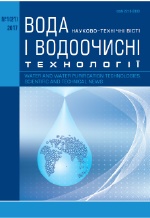The removal of heavy metal (nickel) ions from waste waters
DOI:
https://doi.org/10.20535/2218-93002112017121428Keywords:
nickel, solvent sublation, removal ratio, sodium dodecylsulphate, sublatAbstract
Solvent sublation is a combined method that includes advantages of ionic flotation and liquid extraction. This is a process in which flotation product (sublate) concentrates in a thin layer of organic liquid, which is located on the surface of aqueous phase. There are only a few scattered and unsystematic researches of solvent sublation for water treatment from heavy metal ions. However, such feature of solvent sublation as possibility of metal ions concentration in little volumes of organic solvent independently from distribution coefficient indicates perspective of this method for the treatment of waste waters polluted by heavy metals with the opportunity of metal regeneration. Solvent sublation of nickel ions from low concentrated (20 mg/dm3) aqueous solutions with the use of sodium dodecylsulphate as anionic surfactant was studied. It was discovered, that branched alcohols are better at retention of sublate than those unbranched. Thus, isoamyl alcohol is more effective for solvent sublation than pentanol. Dependences of removal ratio on pH of environment, on molar ratio of Ni2+ : surfactant were researched. The required volume of organic phase was determined. The research of nickel ions removal by solvent sublation from model solutions allowed to determine rational conditions of the process: pH 9, molar ratio of Ni2+ : surfactant = 1 : 2, volume of organic phase 5 cm3. Under these conditions removal ratio of nickel ions into isoamyl alcohol is 95,8%.References
Kim, Young-Sang, Yoon-seok Choi, and Won Lee. "Studies on solvent sublation of trace heavy metals by continuous flow system as ternary complexes of 1, 10-phenanthroline and thiocyanate ion." Bulletin of the Korean Chemical Society 24.12 (2003): 1775-1780.
Lu, Y.J., Liu, J.H., Xiong, Y. and Zhu, X.H., 2003. Study of a mathematical model of metal ion complexes in solvent sublation. Journal of colloid and interface science, 263(1), pp.261-269.
Obushenko T.І., Astrelin I. M., Tolstopalova N. M., Varbanets M. A. and Kondratenko T. A. Wastewater Treatment from Toxic Metals by Flotoextraction // Journal of Water Chemistry and Technology. — 2008. —Vol. 30. — № 4. — P. 241— 245.
Obushenko T.І., Astrelіn І.M., Tolstopalova N.M., Molodchenko M.Є. Zakonomіrnostі procesu flotoekstrakcії pri ochishhennі stіchnih vod vіd іonіv vazhkih metalіv //Naukovі vіstі NTUU „KPІ”. — 2009. — №3. — Р.117—122.
Obushenko T.І., Astrelіn І.M., Tolstopalova N.M., Fedenko Ju.M., Vorozhcov M.A. Doslіdzhennja flotoekstrakcіjnogo viluchennja іonіv mіdі zі stіchnih vod//Vestnik Nacionalnogo tehnicheskogo universiteta «НPI». — 2010. — №11. — Р. 84 — 94.
Obushenko T.І., Astrelіn І.M., Tolstopalova N.M., Kopotun V.P. Flotoekstrakcіja іonіv zalіza z nizkokoncentrovanih rozchinіv // Naukovі vіstі NTUU “KPІ”. — 2010. — № 3. — Р. 106—111.
Bolelyi A.S, Obuchenko T.I, Tolstopalova N.M. Flotoekstraktsiya of nickel ions from aqueous solutions // Young Scientist. — 2017. — №10. — P. 115—118.
Astrelіn І. M., Obushenko T. І., Tolstopalova N. M., Targonska O. O. Teoretichnі zasadi ta praktichne zastosuvannja flotoekstrakcії: ogljad // Voda і vodoochisnі tehnologії. –2013. — № 3. — P. 3—23.
Downloads
Published
How to Cite
Issue
Section
License
Copyright (c) 2020 T. Obushenko, N. Tolstopalova, O. Bolielyi

This work is licensed under a Creative Commons Attribution-NonCommercial 4.0 International License.
The ownership of copyright remains with the Authors.
Authors may use their own material in other publications provided that the Journal is acknowledged as the original place of publication and National Technical University of Ukraine “Igor Sikorsky Kyiv Polytechnic Institute” as the Publisher.
Authors are reminded that it is their responsibility to comply with copyright laws. It is essential to ensure that no part of the text or illustrations have appeared or are due to appear in other publications, without prior permission from the copyright holder.
WPT articles are published under Creative Commons licence:
- Authors retain copyright and grant the journal right of first publication with the work simultaneously licensed under CC BY-NC 4.0 that allows others to share the work with an acknowledgement of the work's authorship and initial publication in this journal. The use of the material for commercial purposes is not permitted.
- Authors are able to enter into separate, additional contractual arrangements for the non-exclusive distribution of the journal's published version of the work (e.g., post it to an institutional repository or publish it in a book), with an acknowledgement of its initial publication in this journal.
- Authors are permitted and encouraged to post their work online (e.g., in institutional repositories or on their website) prior to and during the submission process, as it can lead to productive exchanges, as well as earlier and greater citation of published work.

